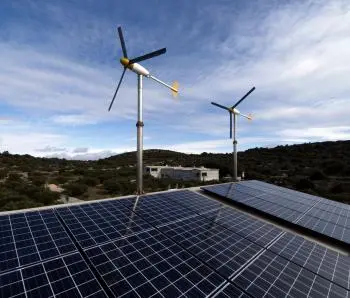
Hybrid solar energy are hybrid energy systems that combine solar energy from a photovoltaic system with another energy source that generates power.
The most common combinations of hybrid solar energy are:
-
Use of diesel generators. They are thermal engines that use derivatives of fossil fuels. Therefore it is a non-renewable source of energy.
-
Use of wind generators. Wind energy is also intermittent but can be complemented quite well by solar energy.
-
Combination of photovoltaic with solar thermal. This type of hybrid system combines the two solar energy technologies in the same solar panel.
Below we mention some examples:
Example 1: solar panels with diesel generators
A common type is a hybrid solar system combining a diesel engine with a photovoltaic system. This type combines solar photovoltaic and diesel generators, or diesel generator sets. Because photovoltaic energy production has an almost marginal cost, it is treated with priority in the grid. Diesel generator sets are used to constantly fill the gap between the current load and the actual power generated by the PV system.
Since solar power fluctuates and the generating capacity of diesel generator sets is limited to a certain range, it is often a viable option to include battery storage. The battery serves to optimize the contribution of the photovoltaic panels to the overall generation of the hybrid system.
Example 2: Solar energy with wind energy
The best business cases for diesel reduction with solar and wind power can typically be found in remote locations. These sites are often not connected to the grid and transporting diesel over long distances is expensive. Many of these applications can be found in the mining sector and on the islands
The combination of wind and solar energy has the advantage that the two sources complement each other because the peak operating times for each system occur at different times of the day and year. The power generation from these hybrid solar installations is more constant and fluctuates less than each of the two component subsystems.
Example 3: photovoltaic and thermal solar energy
Systems that combine photovoltaic cells with thermal production
One of the problems with photovoltaic panels is that the solar panels get hot. This heat is lost energy but it also causes the performance of the photovoltaic cells to drop.
One way to solve this problem is to put the panel in contact with a refrigerator. However, it is much more beneficial if the heat carried away by the refrigerator is stored in a thermal accumulator. We are talking about the hybrid solar panel.
Hybrid solar panels allow generating electrical energy and thermal energy in the same solar panel. This type of renewable energy is ideal for single-family homes.
Hybrid solar collector
The hybrid solar collector is a device that converts solar radiation into electrical and thermal energy. It is made up of solar cells that produce electricity and a solar collector that converts the remaining radiation into thermal energy, the collector also cools the solar cells. The entire system could be described as cogeneration.
In conventional photovoltaics, the efficiency is 14-20% in electricity, in hybrids the remaining 60-70% is converted into heat, so the overall efficiency is much higher. The heat can be used for space heating, domestic hot water, washing machines and dishwashers, and more.
Hybrid inverters
Hybrid inverters are inverters that combine electricity that comes from the conventional electrical grid with batteries.
Mains power is supplied in the form of alternating current while batteries provide direct current. The hybrid inverter is capable of managing and transforming both incoming currents.
Hybrid inverters provide great versatility to the installation of a single-family home.